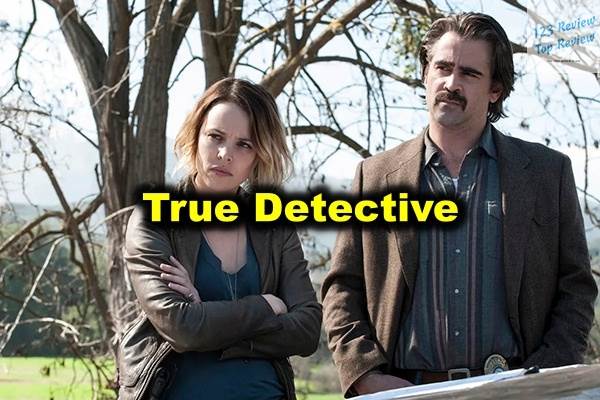Since its debut in 2014, True Detective show has captivated audiences with its blend of intricate storytelling, philosophical musings, and deeply flawed characters. Each season stands as a self-contained narrative, yet all are woven together by recurring themes of existential dread, moral ambiguity, and the eternal struggle between light and darkness.
In this article, 123 Review delves into the series’ rich tapestry, offering an in-depth overview of each season, its characters, thematic elements, and the cultural impact that has made True Detective a landmark in television history.
Season 1: Themes and Plot Development
Narrative Structure and Timeline
Season 1 of True Detective redefined the possibilities of television narrative with its non-linear structure, jumping between 1995, 2002, and 2012. This fractured timeline is not just a storytelling device but a reflection of the fragmented lives of its protagonists, Detectives Rust Cohle and Marty Hart. The investigation into the ritualistic murder of Dora Lange is the thread that ties these timelines together, but the true focus of the season is the exploration of the detectives’ inner worlds and the darkness they uncover within themselves.

The narrative’s non-linear approach creates a layered mystery, where each piece of the puzzle is revealed out of sequence, challenging the audience to piece together the story along with the detectives. This structure also allows the series to explore the concept of time as a flat circle, as proposed by Rust Cohle, where events are destined to repeat themselves, and the past is inextricably linked to the present. The temporal shifts add a sense of inevitability to the story, where the detectives’ pursuit of justice is as much about confronting their own pasts as it is about solving a crime.
Character Arcs: Rust Cohle and Marty Hart
At the heart of Season 1 are the complex character arcs of Rust Cohle and Marty Hart, brought to life by Matthew McConaughey and Woody Harrelson, respectively. Rust Cohle is a nihilistic, introspective detective whose views on life are shaped by personal tragedy and a deep-seated belief in the futility of existence. His philosophical musings, often delivered in a hauntingly calm manner, set the tone for the series, making the audience question the nature of reality and the existence of free will.
Marty Hart, on the other hand, is more grounded but equally flawed. He struggles with infidelity, balancing the pressures of his work with the demands of his family life. Marty’s outwardly conventional life contrasts sharply with Rust’s solitary existence, but as the series progresses, it becomes clear that both men are deeply troubled, their demons merely manifesting in different ways. The tension between Rust and Marty, stemming from their opposing worldviews and Marty’s extramarital affairs, drives much of the drama in the first season. Their partnership is fraught with conflict, yet it also forms the emotional core of the series. Over the course of the investigation, both men are forced to confront their own weaknesses and the moral compromises they’ve made, leading to significant, albeit painful, personal growth.
The culmination of their character arcs is both poignant and redemptive. Rust, who has long believed in the meaningless of life, experiences a moment of clarity and hope at the series’ end, suggesting that there might be something more beyond the darkness. Marty, having faced the destruction of his family, finds a form of reconciliation and peace. The evolution of these characters is not just a journey through the case they are investigating but a journey through their own souls, making Season 1 as much about character study as it is about solving a crime.
Symbolism: The Yellow King and Carcosa
The symbolic elements of Season 1, particularly The Yellow King and Carcosa, add a layer of mythic horror to the narrative, drawing from the works of Robert W. Chambers’ The King in Yellow. These symbols serve as metaphors for the pervasive and insidious nature of evil, suggesting that the darkness the detectives are fighting is not just external but also resides within the human soul.
The Yellow King, a figure referenced in the journals of the victims and in the ramblings of the season’s antagonists, symbolizes the corrupting influence of power and the way it can drive individuals to madness and depravity. Carcosa, often described as a place of nightmares, represents the ultimate destination of those who succumb to this darkness—a place beyond time and sanity. The final confrontation in the maze-like ruins of Carcosa is a symbolic descent into hell, where Rust and Marty must face the embodiment of the evil they have been pursuing.
These elements of symbolism elevate Season 1 from a mere detective story to a cosmic horror tale, where the true terror lies not in the physical acts of violence but in the idea that such evil is an inherent part of the universe. The use of these symbols creates a chilling atmosphere, where the lines between reality and nightmare blur, leaving the audience with an unsettling sense of dread that lingers long after the final credits roll.
Season 2: Evolution and Reception
New Characters and Setting
Season 2 of True Detective shifts away from the Southern Gothic ambiance of the first season, introducing a new cast of characters and a fresh setting in the urban sprawl of California. This season tells a tale of corruption, betrayal, and murder, set against the backdrop of a city where the line between law enforcement and organized crime is perilously thin.
The primary characters—Ray Velcoro (Colin Farrell), a morally compromised detective; Ani Bezzerides (Rachel McAdams), a determined and troubled sheriff’s detective; and Paul Woodrugh (Taylor Kitsch), a highway patrol officer with a dark past—each bring their own personal baggage to the investigation. Their lives intersect through a high-profile murder that exposes the underbelly of California’s political and economic landscape.
Ray Velcoro is perhaps the most tragic figure of the season, a man who has sacrificed his morals and his soul in the name of revenge and survival. His relationship with his son and his quest for redemption drive much of his arc, culminating in a poignant and tragic conclusion. Ani Bezzerides is a strong, independent woman battling her own demons, including a traumatic past and a strained relationship with her family. Her character represents the struggle of maintaining integrity in a world where corruption is the norm. Paul Woodrugh’s journey, marked by secrets and self-loathing, adds another layer of complexity, as he grapples with his identity and the consequences of his past actions.
Critical Response and Audience Reception
Season 2 was met with a more divided reception compared to its predecessor. While some critics appreciated the ambition and the performances of the cast, others found the narrative too convoluted and the characters less compelling than those in Season 1. The season’s darker, more cynical tone, coupled with its intricate plot, made it a challenging watch for some viewers, resulting in lower ratings and less critical acclaim.
Despite this, Season 2 has garnered a dedicated following over the years, with some viewers revisiting it and finding new appreciation for its complexity and its attempt to tackle large-scale corruption and moral decay. The season’s bold narrative choices, while not universally loved, reflect the show’s willingness to take risks and push the boundaries of traditional crime drama. The dense plotting and the intertwining of personal and professional dilemmas make Season 2 a rich, if sometimes uneven, viewing experience.
Connections to Season 1 Themes
Although Season 2 departs significantly from the style and structure of Season 1, it continues to explore similar themes, such as the corrupting influence of power, the inescapability of the past, and the moral compromises that define the characters’ lives. The idea of systemic corruption—whether in the police force, politics, or business—serves as a backdrop to the personal struggles of the protagonists, much like the hidden darkness of Louisiana’s bayous in Season 1.
Thematically, Season 2 also delves into the concept of inescapable fate, a recurring motif in True Detective. The characters’ lives are shaped by their pasts, their choices leading them inexorably toward a tragic destiny. This fatalism echoes Rust Cohle’s musings on time and existence, tying the two seasons together despite their different settings and narratives. In this way, Season 2 serves as a continuation of the show’s exploration of the darker aspects of human nature and the often grim realities of seeking justice in a flawed world.
Season 3: Returning to Form
Gripping Narrative Techniques
After the divisive reception of Season 2, True Detective returned with a third season that many fans and critics hailed as a return to form. Set in the haunting landscape of the Ozarks, Season 3 revisits the complex, non-linear storytelling that made the first season so compelling. The season follows Detective Wayne Hays, portrayed with remarkable depth by Mahershala Ali, across three time periods: 1980, 1990, and 2015. This fractured narrative structure, combined with a gripping mystery involving the disappearance of two children, creates a tense, atmospheric thriller that keeps viewers on the edge of their seats.
The use of multiple timelines not only enhances the suspense but also allows for a deeper exploration of the characters and the impact of the case on their lives. As the story shifts between the past and the present, the audience witnesses the gradual unraveling of the mystery, alongside the deterioration of Hays’ memory and the toll the investigation takes on him over the decades. This narrative technique adds a layer of psychological complexity to the season, blurring the lines between reality and recollection, and emphasizing the subjective nature of memory.
Character Relationships and Development
Wayne Hays is a character haunted by the ghosts of his past, both literal and figurative. His relationship with his wife, Amelia (Carmen Ejogo), a teacher and author who becomes deeply involved in the case, is central to the narrative. Their marriage, strained by the pressures of the investigation and Hays’ increasing obsession with the case, offers a poignant exploration of the personal sacrifices made in the pursuit of justice. The dynamic between Hays and Amelia is both tender and fraught, providing a rich emotional core to the season.
Hays’ partnership with Detective Roland West (Stephen Dorff) also forms a key element of the story. Their friendship, marked by loyalty, respect, and moments of tension, is tested by the passage of time and the unresolved nature of the case. As they grow older, the weight of their shared history becomes more apparent, with the investigation serving as both a bond and a burden. The evolution of their relationship, particularly as Hays grapples with his fading memory, adds a layer of tragedy to the season, highlighting the personal cost of their decades-long search for the truth.
Recurring Themes of Time and Memory
Season 3 delves deeply into the themes of time and memory, using them as both a narrative device and a thematic exploration. Hays’ struggle with memory loss in his later years mirrors the fragmented storytelling, where the truth of the case is obscured by the passage of time and the unreliability of human recollection. This theme is reinforced by the season’s frequent use of flashbacks and shifts in perspective, which challenge the audience to piece together the mystery alongside the protagonist.
The season’s exploration of memory also touches on the idea that the past is never truly gone, but rather it lingers, shaping the present and future. For Hays, the unsolved case represents unfinished business, a wound that never healed. As the narrative unfolds, it becomes clear that the search for answers is not just about solving a crime, but about confronting the ghosts of the past and finding closure. This focus on time and memory ties Season 3 to the broader themes of True Detective, where the quest for truth is always intertwined with the passage of time and the burden of memory.
Season 4: Expansion of the Series
Introduction of New Leads: Jodie Foster and Kali Reis
Season 4 of True Detective promises to take the series in a bold new direction with the introduction of two new leads, played by Jodie Foster and Kali Reis. Set against the stark, remote landscape of Alaska, this season is poised to explore themes of isolation, survival, and the intersection of crime and wilderness. The casting of Foster and Reis, both known for their strong, complex performances, suggests a focus on character-driven storytelling, with a particular emphasis on the psychological and emotional challenges faced by the protagonists.
The Alaskan setting, a departure from the previous seasons’ more urban or Southern locales, introduces a new visual and thematic element to the series. The harsh, unforgiving environment of Alaska could serve as a metaphor for the characters’ internal struggles, reflecting the isolation and desolation that often accompany the search for truth in the True Detective universe. The setting also opens up possibilities for exploring new cultural contexts and societal issues, such as the challenges faced by indigenous communities and the impact of environmental extremes on human behavior.
Underlying Themes and Cultural Context
While details about Season 4 are still emerging, it is expected to continue the series’ tradition of exploring complex, often dark themes through the lens of a murder investigation. The themes of isolation and survival, inherent in the Alaskan setting, may be juxtaposed against the broader human experience, examining how individuals cope with extreme circumstances and the moral choices they make in the face of adversity.
The cultural context of Alaska, with its unique blend of indigenous traditions and modern challenges, could also provide a rich backdrop for the narrative, allowing the series to delve into issues such as cultural identity, the impact of colonization, and the tension between traditional ways of life and contemporary society. This exploration of cultural themes, combined with the show’s established focus on psychological depth and moral ambiguity, suggests that Season 4 will continue to push the boundaries of what a crime drama can explore.
Connection to Previous Seasons
Despite its new setting and characters, Season 4 is likely to maintain thematic continuity with the previous seasons, particularly in its exploration of darkness, both external and internal. The themes of isolation, survival, and the search for truth in a harsh, unforgiving world are consistent with the broader motifs of True Detective, where the environment often mirrors the psychological states of the characters.
The connections to previous seasons may also be found in the series’ ongoing exploration of the impact of the past on the present, the moral complexities of justice, and the ways in which individuals confront (or are consumed by) the darkness within. While each season of True Detective stands alone, these recurring themes create a cohesive narrative thread that ties the series together, offering a rich, layered exploration of the human condition.
Cultural Impact of True Detective
Influence on Crime Drama Genre
True Detective has left an indelible mark on the crime drama genre, setting a new standard for storytelling, character development, and thematic depth. Its influence can be seen in the wave of crime dramas that followed, many of which have adopted similar techniques, such as non-linear storytelling, complex character arcs, and a focus on philosophical or existential themes. The show’s success demonstrated that audiences are hungry for more than just procedural crime-solving; they crave narratives that challenge them intellectually and emotionally.
The series’ impact extends beyond its narrative techniques. True Detective has also pushed the boundaries of what television can achieve in terms of visual style and atmosphere. The haunting, atmospheric cinematography of Season 1, in particular, has been widely praised and has influenced the visual approach of many subsequent crime dramas. The use of long takes, moody lighting, and evocative landscapes has become a hallmark of the genre, thanks in large part to the precedent set by True Detective.
Reception by Critics and Awards
True Detective has garnered significant critical acclaim, particularly for its first and third seasons. Season 1 was lauded for its groundbreaking narrative structure, the depth of its characters, and its philosophical undertones. Matthew McConaughey’s portrayal of Rust Cohle was widely praised, earning him numerous awards and nominations, including a Primetime Emmy nomination and a Critics’ Choice Television Award.
Season 3, with Mahershala Ali in the lead role, also received critical acclaim, with many praising Ali’s performance as one of the best on television that year. The season was seen as a return to the form that made the first season so successful, and it earned several award nominations, including a Primetime Emmy nomination for Outstanding Lead Actor in a Limited Series or Movie for Ali.
While Season 2 received a more mixed reception, it too was recognized for its ambitious storytelling and strong performances, particularly from Colin Farrell and Rachel McAdams. The series as a whole has been celebrated for its willingness to take risks, its exploration of complex themes, and its contributions to the evolution of television as a serious artistic medium.
Fan Theories and Speculations
True Detective has inspired a passionate and engaged fanbase, with viewers delving into the show’s rich symbolism, complex narratives, and open-ended questions. Fan theories abound, particularly regarding the connections between seasons, the deeper meanings behind the show’s symbolism, and the fate of its characters. From speculation about the true identity of the Yellow King in Season 1 to debates about the ambiguous ending of Season 3, fans have embraced the show’s mysteries, creating a vibrant community of discussion and analysis.
These fan theories often explore the possibility of a shared universe within the series, where seemingly unrelated events and characters are connected by underlying themes or hidden narrative threads. Theories about recurring motifs, such as the significance of time and memory, or the show’s exploration of cosmic horror, reflect the depth and complexity of True Detective, which invites multiple interpretations and rewards close, thoughtful viewing.
Future of True Detective
Speculations on Season 5
As of now, HBO has not confirmed a fifth season of True Detective, but speculation about the future of the series continues to thrive. Given the show’s anthology format, which allows for new stories and characters with each season, there is endless potential for where the series could go next. Fans and critics alike are eager to see how the show will continue to evolve, particularly in terms of character development, thematic exploration, and the introduction of new settings.
Potential directions for Season 5 could include exploring different time periods, cultural contexts, or even different genres within the crime drama framework. The series’ ability to reinvent itself with each season, while maintaining a core set of themes and motifs, opens up a wide range of possibilities. Whether through the introduction of new characters, the exploration of new themes, or the revisitation of ideas from previous seasons, True Detective has the potential to continue pushing the boundaries of television storytelling.
Potential Directions for Character Development
One of the most compelling aspects of True Detective has always been its character development. Future seasons could build on this strength by introducing more complex, multi-dimensional characters who grapple with both external conflicts and internal struggles. Whether through the lens of law enforcement, criminal enterprises, or ordinary individuals caught in extraordinary circumstances, the show could continue to explore the psychological and moral depths of its characters.
Given the series’ focus on flawed, often damaged protagonists, future seasons could also delve deeper into themes of redemption, guilt, and the consequences of past actions. The introduction of new cultural contexts or settings could add fresh dimensions to these themes, allowing the show to explore different facets of the human experience. Additionally, the possibility of revisiting characters or storylines from previous seasons could provide opportunities for further character development and thematic exploration, creating a richer, more interconnected narrative universe.
Lasting Legacy and Thematic Continuity
Regardless of what the future holds for True Detective, its legacy is already secure. The show has redefined what is possible in the crime drama genre, combining intricate narratives, deep character studies, and philosophical themes in a way that has resonated with audiences and critics alike. Its influence on television storytelling, visual style, and thematic exploration will be felt for years to come, inspiring future generations of creators and viewers.
The thematic continuity that runs through each season of True Detective—the exploration of darkness, the search for truth, and the struggle between good and evil—ensures that the series will remain a powerful, thought-provoking work of art. As long as the show continues to delve into these timeless themes, it will retain its relevance and continue to captivate audiences, regardless of the specific stories or characters it chooses to explore.
In conclusion, True Detective stands as a testament to the power of television to tell complex, meaningful stories that resonate on both an intellectual and emotional level. With each season offering a unique take on the crime drama genre, the series has carved out a place in television history as a groundbreaking, influential work that will be studied, discussed, and admired for years to come.





